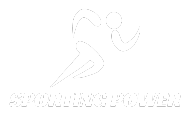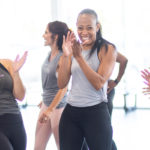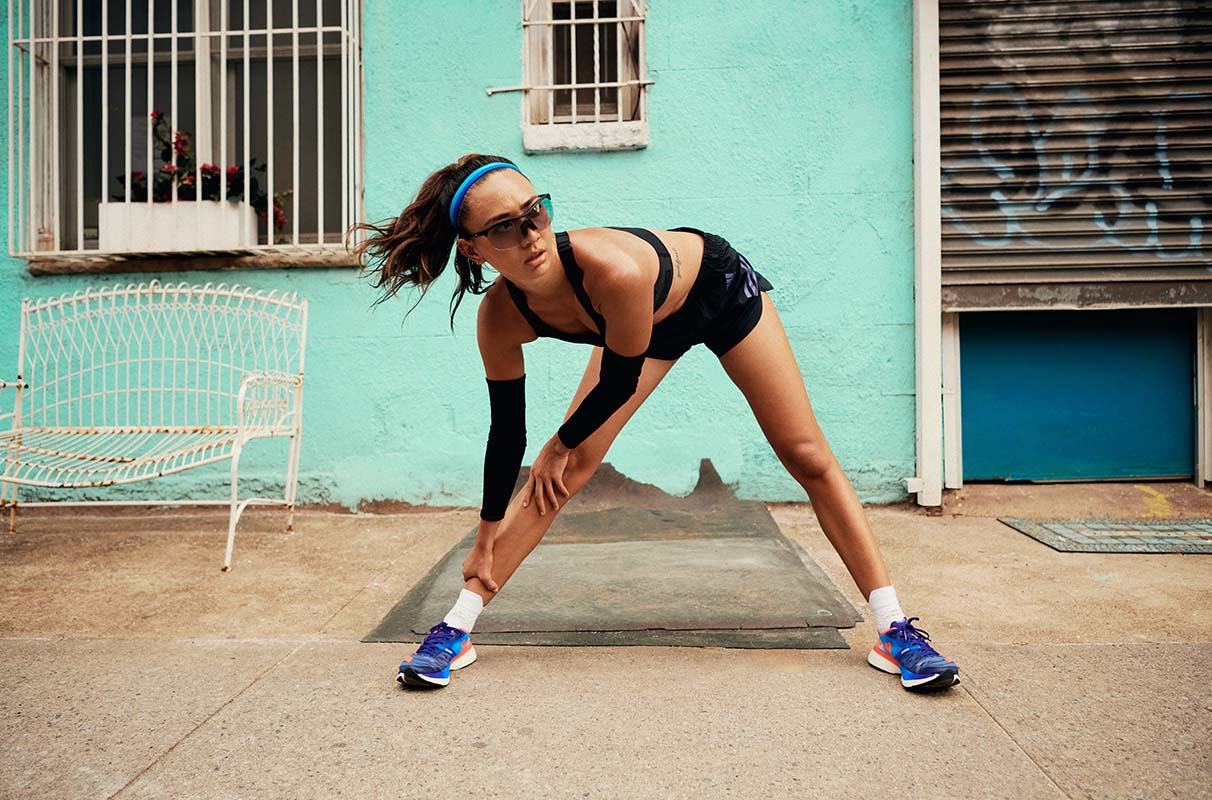What is Hatha Yoga?
Hatha means forceful in Sanskrit. The school of yoga uses the body to achieve a state spiritual perfection. The origins of the school can be traced back to Gorakhnath who was a Hindu saint and yogi in the 11th century.
Hatha yoga is an adapted form of yoga which combines yoga poses and breathing techniques. The goal of training yoga poses is to build energy, flexibility and endurance to be able to sit in seated mediation for long periods.
Hatha yoga is a gentle and slow yoga class that’s perfect for beginners. Hatha yoga is perfect for those who want a more gentle form of yoga that’s suitable for all levels.
The Hatha Yoga course can vary depending on the studio, trainer and time of the day. Hatha yoga classes can be more dynamic in the morning, helping people to wake up and feel energized throughout the day. A night Hatha class may focus more on static poses and long stretches to help the body relax and encourage quality sleep.
Hatha yoga is a branch of yoga that includes many different types of yoga. They range from more passive and stress-free types of yoga (such as yin) to the more physically demanding kinds (such as Ashtanga).
What to Expect in a Hatha Yoga class
Hatha Yoga classes include a variety static poses, breathing exercises, relaxation, and some movement guided by the breath. Hatha yoga is accessible to beginners and all levels of experience because it focuses on alignment and breathing.
A Hatha Yoga class may also include pranayamas, philosophy and meditation, depending on the instructor and the students in the class. Hatha classes are often tailored to fit the class setting, so they tend to vary a lot.
If you’re a Hatha Yoga beginner, it is a good idea to try out different classes with various lecturers in a variety of yoga studios, until you find the combination that works for you.
Hatha Yoga E-book
You can find the paperback version of Hatha Yoga Prdipika: Translation With Notes From Krishnamacharya on Amazon. This guide is unique because it is not only a translation of Hatha Yoga Pradipika, one of the most well-known texts about physical yoga, but also contains the views of Krishnamacharya. He is known as the father of modern yoga.
Hatha yoga advantages
Over the years, there have been an increasing number of academic studies on the health advantages of yoga.
Elevated Power
Hatha Yoga has been studied for its physical and mental benefits. 26 participants took part in the study and practiced Hatha Yoga for six weeks. A group of participants also practiced Ashtanga for six weeks. The results showed that the Hatha Yoga group had significantly improved their trunk muscular power, endurance and flexibility at the end of six weeks.
Low persists again
A study examined if Hatha yoga could help people with low back pain that is persistent. This study involved 22 participants, who were divided into two groups: a yoga group with no yoga training and a control group. The yoga group did Hatha yoga twice a week for an hour. The outcomes confirmed that the yoga group skilled improved stability, flexibility, and decreased incapacity and melancholy in addition to leisure and new consciousness/studying.
Well-being and total well-being
A review article examined articles that examined the benefits of a daily yoga practice. Many studies have shown that yoga can reduce, eliminate, or prevent structural, physiological and emotional pain, suffering, or limitations. They concluded from their review that yoga could help: “improve muscular power and body flexibility, promote and improve respiratory and cardiovascular performance, promote recovery from and therapy for habit, reduce stress, anxiety, melancholy and persistent pain, enhance sleep patterns and improve overall well-being.”
How to observe Hatha Yoga
Hatha yoga is a great class to start out with yoga. You will learn how to breathe effectively and to use your breath to guide your actions.
Who would possibly like such a Yoga?
Yoga beginners or anyone looking for a practice that will help them improve their flexibility and energy, but is not too strenuous on their body.
What equipment you need to practice Hatha Yoga at home
Manduka’s eco-friendly tree rubber yoga mat is a good option.
Hatha Yoga Video
Now let’s move on to the different types of yoga and its benefits.
Ashtanga yoga
What’s Ashtanga yoga?
Ashtanga is a very structured form of yoga taught by Shri T Krishnamacharya, also known as “the father of modern yoga”. He taught Shri Ok Pattabhi Jois the Ashtanga Yoga practice, which he redeveloped. It became popular in the US and then around the world.
Ashtanga Yoga, also known as Ashtanga Vinyasa Yoga, is a physically demanding and dynamic yoga practice that involves a series of poses. Each pose is performed for five breaths.
The set sequence is an order of postures that is intended to cleanse, stretch and strengthen the body and, over time, purify and stabilize the mind.
Ashtanga yoga consists of six sequences of poses. Ashtanga Yoga’s first collection is so challenging that many people only do it.
For these considering beginning Ashtanga yoga, learn my article: Ashtanga Yoga For Learners: A Detailed Information
What to Expect in an Ashtanga Yoga class
Ashtanga yoga is not only a great form of exercise, but it can be adapted to beginners. Ashtanga is taught in two ways:
The trainer leads the class. The complete major collection can be too advanced for beginners. Look for a class that teaches the half major collection if you are a beginner.
Mysore classes, where the instructor does not inform the class. Each student learns and practices the sequence at his or her own pace. This course is perfect for beginners as the instructor will give them verbal and physical instructions. The class is also a great place for people of all levels to work together. The practitioner can be a newbie or have been in training for 2 years.
E-book on Ashtanga yoga
Ashtanga yoga has so many books that you can recommend. The Energy of Ashtanga Yoga, by Kino McGregor is one book I would recommend. You can find the paperback or kindle version on Amazon.
This guide is unique in that it covers the Ashtanga historical past, the Ashtanga technique and the yoga diet. Each pose in the Ashtanga major collection is described very clearly and thoroughly, followed by an explanation of its benefits.
For a extra detailed checklist on ashtanga yoga books take a look at my article: The 23 Finest Ashtanga Yoga Books
Ashtanga Yoga Advantages
Weight loss and proper health
In one study, the effect of Ashtanga Yoga on weight and self-concept was examined in adolescents at risk for developing type 2 diabetes. This study involved 20 children and adolescents who practiced Ashtanga Yoga 3 times per week for a period of 12 weeks. The results of the study confirmed that Ashtanga Yoga could be helpful as a method for weight loss. The study also confirmed that Ashtanga yoga could help improve low self-esteem and anxiety.
Physique acceptance
A study examined the effect of Ashtanga on body awareness amongst survivors who have experienced complex childhood trauma. The study included 31 women who were already Ashtanga practitioners. The study revealed that the women had experienced some form of abuse (emotional and physical, as well as sexual), and found Ashtanga to help them control their feelings and improve their body consciousness.
The researchers of the study went on to say that: “Such results suggest that a continuous Ashtanga Yoga practice could assist female survivors of complex trauma improve their capability to control their feelings as well as enhance their body consciousness, leading to an improved awareness of various points of expertise.”
For extra info on ashtanga yoga advantages, take a look at my article: 10 Fantastic Ashtanga Yoga Advantages
Ashtanga Yoga: How to observe it
We begin by doing the sun salutations, which warm up the body and prepare us for standing postures. Then we move on to seated postures. Each class ends with a different version of the final poses.
Ashtanga Yoga sequence is designed so that each posture provides a necessary basis for all the following postures. The more we practice, the stronger our body becomes and the more postures are available to us.
Who could possibly enjoy such a Yoga?
People who are energetic and like to challenge their bodies. Ashtanga Yoga is perfect for people who want to calm their thoughts.
What equipment you need to practice Ashtanga Yoga at home
Maduka Professional yoga mat is a popular mat for Ashtanga practitioners. It comes with a lifetime guarantee when purchased and shipped by Amazon.com.
Video of Ashtanga yoga
Vinyasa yoga
What’s Vinyasa Yoga?
Vinyasa is one of the most popular types of yoga practiced in Western yoga studios. It is more dynamic than a Hatha class, and its structure is not as fixed as Ashtanga. Individual poses are linked to the breath, and together they form a flowing motion sequence that is different for every class.
Vinyasa can be called Vinyasa flow, if the sequence is seen as a continuous flow of different postures. This flow can become more advanced depending on the instructor and the students in the class.
Some classes will focus on opening up one particular part of the body. The students can then prepare their body and mind and guide them to more advanced poses.
Vinyasa helps to improve flexibility and energy. It can also be a fun kind of sophistication, provided that students don’t always know which pose will come next.
What to Expect in a Vinyasa Yoga class
The majority of vinyasa courses are designed for each level, unless otherwise stated. The lecturer will usually present modifications to make the class accessible for beginners.
Vinyasa courses tend to include some sun salutations, standing postures and a mix of seated forward folds, spinal twists and core strengthening exercises, as well as conversations. The chosen poses are determined by the instructor’s plan.
If the instructor decides to focus on inversions they will most likely guide students through a series of postures that balance, strengthen core muscles, and build up arms.
E-book on Vinyasa yoga
You can find the paperback or Kindle version of Mastering Vinyasa Yoga on Amazon.
This guide is unique because Raji Thron explains how to perform each pose and shows poses with pictures and descriptions. This type of information is very useful, especially for those who practice at home.
Vinyasa Yoga Advantages
Vinyasa yoga has many benefits. Here are just a few.
Melancholy
In one study, the effect of Vinyasa on depression was examined. The study involved 11 participants with melancholy who had never practiced yoga. The participants were encouraged to attend at least 1.5 classes per week, for a minimum of 8 weeks. After two months, contributors reported a significant decrease in depressive symptoms.
Yoga also has some additional benefits for these participants. They included:
Emotional (feeling calm, relaxed and crying less)
Bodily (better sleep, weight loss, reduced ache)
Social (connecting with others in the class)
Stress
In one study, the influence of vinyasa on young adults in college was examined. An optimistic impact can help reduce stress levels. When someone has a positive impact, they are more likely to experience positive feelings and be able to handle life’s challenges in a positive way.
Twenty participants took part in this study and attended vinyasa classes twice per week over a period of 8 weeks. The stress levels were measured before and after each class. This study revealed that the students’ impact measure had improved significantly after two months of yoga classes.
What is Vinyasa Yoga?
The stream will be revealed to us through the breath.
These classes are likely to move on to poses that help to warm the body. Some of these can be variations of the solar salutations. Depending on the focus of the class, the instructor might guide the group by a combination of standing poses and those that will help students prepare for the pose they are focusing on.
Each class ends with a model of a closing pose, which is designed to calm the nervous system down after completing a physically demanding application.
Both beginners and more experienced yogis can practice vinyasa, since modifications and advanced variations are usually taught.
Who could possibly enjoy such a Yoga?
People who are energetic and like to challenge their bodies. Vinyasa is also great for those who do not need to be aware of the next pose or series of poses.
What equipment you need to practice Vinyasa Yoga at home
Yoga mat – You should have a durable yoga mat as it is likely to be subjected to a lot of wear and tear. One in style yoga mat for Vinyasa yoga is the Manduka eco mat. This mat is designed to grip during sweaty Vinyasa Yoga practices.
Video of Vinyasa yoga
A side note, I have written an article where I compare Hatha to Ashtanga or Vinyasa. Check it out to learn their main variations!
What is Yin Yoga?
Yin Yoga is a class that moves at a very slow pace. We hold each pose for 2-5 minutes. The purpose of Yin yoga is to stretch the connective tissues. It’s the perfect complement to more physically demanding types of yoga like Vinyasa or Ashtanga.
Yin Yoga is a type of yoga which benefits those who are looking for the best yoga to stretch. You will notice a significant increase in flexibility after just one class. You will feel relaxed and calm after these extended stretches.
I recommend yin for beginners, as long as the instructor has the time to explain the benefits of each pose and the different aspects of yin. I also recommend yin for those who are recovering from an injury, as the poses can be adjusted to fit all body types and issues with props.
What to Expect in a Yin Yoga class
You can learn to stay still in poses that seem to stretch your entire existence! Several stretches can be intense, but they also feel great. The Yin Yoga poses are meant to help release any trapped pressure in the body.
This is a great class for beginners because they get to feel their body in certain poses. This will also help them to train more dynamic forms of yoga.
Yin Yoga is a type of yoga that uses props. They are used as a way to open and lengthen the body in an optimal manner. Mendacity with a block beneath the shoulder blades, for example, is a great pose to help open the chest.
This is a great one for my students who spend a lot time in front of the computer.
E-book on Yin Yoga
If you are looking for a book on yin-yoga, I suggest The Full Information to Yin Yoga : The Philosophy and Observe Yin Yoga available in both paperback and Kindle format from Amazon.
This guide is unique in that it explains yin yoga and its benefits. Then, using very clear images, 30 yin poses are demonstrated, along with an explanation of how to perform each pose and its benefits.
Yin Yoga Advantages
Stress and Fear
In one study, the effects of yin on stress perception, fear and mindfulness were examined. The study involved forty participants. Nineteen were placed in the yoga group, who practiced yin twice per week for a period of five weeks. The other 21 participants were in the management group, who had been placed on a list and did not practice yoga.
The results of this study confirmed that yin-yoga was able to reduce stress and anxiety, as well as improve mindfulness. These modifications were still evident 5 weeks after the study ended.
Stress, anxiety, and depression
A study examined the effects of yin Yoga on stress, anxiety, and depression, which are all responsible for non-communicable diseases (e.g. Heart problems are responsible for the majority of premature deaths in the world.
This study was conducted by 100 participants, who were divided into three groups. Group 1 did yin for five weeks, while group 2 did yin and mindfulness. Group 3 was the control group, and they did not practice yoga. The results confirmed that teams 1, 2, and 3 showed better stress reduction and reduced melancholy compared to the management team. As expected, Group 2 had the best results of all the teams.
Check out my article for more information on the yin benefits: 10 Amazing Yin Benefits
How to observe:
Yin Yoga involves holding poses for a long time, usually 2-5 minutes. This allows the body to stretch the connective tissues. You’ll leave the class feeling relaxed. The pressure that you have built up throughout the day will be absorbed by your yoga mat.
Who could possibly enjoy such a Yoga?
Anyone who wants to practice a slow and peaceful form of yoga or improve their flexibility.
What equipment you need to practice yin Yoga at home
Yoga mat: You’ll get a mat that is thick and cushioned to protect your joints. The Maduka Professional mat is a great choice. It comes with a lifetime guarantee when purchased and shipped by Amazon.com.
Yoga blocks – These are the yoga blocks you will need to perform yin poses.
Video of Yin Yoga
Iyengar yoga
What’s Iyengar Yoga?
Iyengar Yoga is based on the teachings B.Ok.S. Iyengar was a student of Krishnamacharya who is known as the “father of modern yoga”. Here, the emphasis is on the precise method and alignment for around 200 specific yoga poses.
Poses are held for an extended time. During this time, students are encouraged to pay attention to their alignment and try to correct it. The students’ bodies can then go deeper into their pose.
This is a physically demanding application. It is a very different course from Ashtanga or Vinyasa because it uses fewer poses. Instead of rushing from one pose into the next, precision is emphasized.
Holding difficult poses helps to improve energy and stamina in both the body and mind.
What to Expect in an Iyengar Yoga class
In an Iyengar Yoga class, modifications and changes are made. Props are used in this class because of the nature of Iyengar yoga, which is to ensure proper alignment.
E-book on Iyengar yoga
B.Ok.S. is the guide I would recommend for Iyengar Yoga. Iyengar wrote Iyengar Yoga, The Path to Holistic Health. This guide is available in both hardcover and Kindle format on Amazon. It contains Iyengar’s philosophy and step-by-step instructions and illustrations for over 55 poses.
Iyengar Yoga Advantages
Osteoarthritis
In one examine, it was examined if Iyengar Yoga can help those who suffer from knee osteoarthritis. This study involved 66 participants with knee osteoarthritis who were divided into two groups. Group 1 did Iyengar Yoga for six days. Group 2 was a control group that didn’t do any yoga. The results confirmed that the yoga practitioners had increased muscular energy, flexibility and useful mobility.
Low again ache
Iyengar Yoga was examined on people with low back pain. The study involved 42 participants with low back pain. They were divided into two groups: Group 1 did Iyengar Yoga for 16 weeks and Group 2 did not practice yoga.
The results of this study showed that the yoga group experienced a significant reduction in pain, disability, and pain medication use. These results were still there three months after the study ended.
How to apply
There are no transitions or vinyasas between poses. Props are often used to help the body go deeper into each pose.
Who could possibly enjoy such a Yoga?
This type of yoga is good for anyone with an injury who needs to take time in each pose. Also, anyone who enjoys exploring different yoga poses.
What equipment is required to practice Iyengar Yoga at home?
The Liforme Yoga Mat is a great mat for Iyengar Yoga. The mat comes with additional alignment markers to allow for as much or as little steering as desired.
Yoga blocks – These are the yoga blocks you will need to perform yin poses.
Yoga straps – The Manduka Unfold Yoga Strap is a good option.
Video of Iyengar yoga
Aerial Yoga
What is Aerial yoga?
Aerial yoga is a class where you perform yoga poses using a silk hammock suspended from the ceiling. A hammock can help build flexibility and strength. The hammock allows beginners to perform more difficult poses without putting strain on their arms, backbone or top.
Aerial Yoga is a fun form of yoga. Its main benefit is its novelty, and the use of an aerial yoga hammock. Aerial yoga is a fun way to build core and body strength. It could also help those with back pain, as the inversion helps to create space between each vertebra without straining the spine.
What to Expect in an Aerial Yoga class
Each student has their own aerial hammock, which is placed on top of a mat. The instructor guides the students through a variety of poses depending on the type of yoga class.
It is important to note that the hammock allows students to perform poses more easily and efficiently. Aerial yoga poses include lunges on one leg, half-splits on one leg, and backward bending poses such as camel pose.
Book on aerial yoga
Aerial yoga: The Low Fly Zone is the guide I recommend for aerial yoga. This guide will be useful for both beginners and advanced aerial practitioners because it includes over 40 poses and variations.
Aerial Yoga Advantages
While doing research for this article, I didn’t expect to find any articles that discussed the benefits of aerial yoga. To the best of my data, there have been no research done to date.
However, I came across a suggestion for how aerial yoga could help women survivors of sexual abuse. After reading their reasoning, I was blown away by the benefits they mention.
Below are two parts of their proposal I found fascinating:
The aerial silk can help customers build confidence and develop a more attuned relationship to their body, while taking into consideration their own needs.
The purchaser can create a soft and supportive cocoon that will draw them inwards and create an protecting body house.
C. Louise revenue, Aerial Yoga for Trauma and loss
Aerial Yoga: How to observe it
The hammock can be used for aerial yoga as a way to help your body and provide information.
Who could possibly enjoy such a Yoga?
Anyone looking for a fun and unique way to practice yoga. Also, anyone who wants to practice inversions and backends in a safe and more gentle way.
What equipment you need to do aerial yoga at home
Amazon’s aerial yoga hammock has received many positive reviews. The hammock also comes with a daisy chain and carabiner. The product is also available in a variety of colours.
You will also need the yoga trapeze hooks to attach your hammock to the ceiling.
Manduka’s eco-friendly tree rubber yoga mat is a good option.
Aerial yoga video
Restorative Yoga
What is Restorative Yoga?
Restorative Yoga is the least stressful form of yoga that you will ever try. This is a very gentle yoga class where the body is placed in some very relaxing restorative poses. Restorative Yoga uses many yoga props to enhance or deepen this very relaxing experience.
Restorative Yoga courses are a great combination for those who have been training more dynamic yoga practices. These courses are also great for those who want to soften their body and things onto the mat.
What to Expect in a Restorative Yoga class
It may not be as simple to think about a restorative class. There’s no place for the mind to escape. The body is placed in extremely comfortable and restorative poses. This helps us to experience complete give up.
Restorative classes are usually very tranquil and calm.
Restorative Yoga E-Book
This is the guide I would recommend for restorative Yoga: Loosen Up and Renew – Restful Yoga for Nerve Wracking Situations. This book is for anyone who wants to learn about the physical postures and breathing techniques used in restorative Yoga.
Restorative Yoga Advantages
Spirituality, peace, psychological well-being, and melancholy
A study examined the impact of Restorative Yoga on cancer patients and survivors after treatment. Forty-four women with breast cancer took part in 10 weekly 75 minute restorative Yoga courses. After ten weeks there was a significant improvement in mental health, melancholy and positive affect. Women with lower well-being benefited more from the yoga intervention compared to women in the control group who didn’t practice yoga.
Sleep High Quality
Restorative Yoga and sleep: A study. This study was conducted on cancer survivors who reported that between 30-90% had poor sleep quality following their treatment. Four hundred and ten cancer survivors participated in this study and half took a 75-minute yoga class twice a week for four weeks.
Restorative Yoga had a positive impact on the sleep quality and effectiveness of participants.
How to apply
For this type of yoga, you’ll be using a variety of props. You will feel more relaxed with the help of all props. Each class may only include a few yoga poses. You can hold each pose for up to 10 minutes.
Who could possibly enjoy such a Yoga?
Anyone who wants to relax and release all pressure.
What equipment do you need to practice restorative Yoga at home?
Yoga mat: You’ll get a mat that is thick and cushioned to protect your joints. The Maduka Professional mat is a great choice. It comes with a life-time guarantee when purchased and shipped by Amazon.com.
You’ll have a heat and mushy blanket. This blanket is used to help you into the poses, and also for savasana.
Yoga bolsters – These bolsters will make your restorative class a success. This particular yoga bolster comes in many colours, is durable and will not lose its shape.
Eye pillows can help you relax and drift off to sleep. This particular eye pillow features a natural lavender and flaxseed filling. The sleeves are machine washable and were hand knitted in the USA.
Video of Restorative yoga
Prenatal Yoga
What is Prenatal Yoga?
Prenatal yoga is an approach to yoga that targets women during their pregnancy. It uses gentle poses and stress-free techniques to help mums feel open and strong and to prepare them for childbirth. It may also help improve stability and power levels.
What to Expect in a Prenatal Yoga class
Only yoga instructors who are trained in prenatal Yoga should teach these courses. These courses aim to help mums feel more flexible and stronger.
This is a special kind of sophistication which helps to build friendships, and allows for the expression of shared experiences within a class.
Prenatal Yoga E-book
Yoga Mama, Yoga Child Ayurveda & Yoga for a Healthy Being Pregnant and Beginning is a guide that I would recommend for prenatal yoga. This guide is unique because it includes month-to-month exercises, tricks to encourage natural labor and advice on how to stay healthy and happy in the first weeks after delivery.
Prenatal Yoga Advantages
Antenatal melancholy
One study examined the effect of yoga on antenatal depression. This study involved 34 pregnant women who were depressed. The women took part in a 75 minute prenatal yoga class, twice a week, for 10 weeks. The results showed that the girls’ melancholy had decreased significantly by the end of the study.
Stress and Immune Perform
In a second being pregnant study, women took part in a 20 week intervention that included two weekly prenatal yoga sessions of 70 minutes each. The results confirmed that prenatal exercise was able to significantly reduce pregnant women’s stress levels and improve their immune system.
What can one observe?
Prenatal yoga relies on your intuition to change poses, and props are used instead of flexibility or energy.
What equipment do you need to practice restorative Yoga at home?
You can protect your joints with a yoga mat that is thick and cushioned. The Maduka Professional mat is a great choice. It comes with a life-time guarantee when purchased and shipped by Amazon.com.
Yoga blanket – You’ll have both a heat and a mushy blanket to help you with poses, and also for savasana.
Yoga bolsters – These bolsters will make your prenatal class a success. This particular yoga bolster comes in many colours, is durable and will not lose its shape.
Eye pillows will help you relax and drift off to sleep. This particular eye pillow features a natural lavender and flaxseed filling. The sleeves are machine washable and were hand knitted in the USA.







